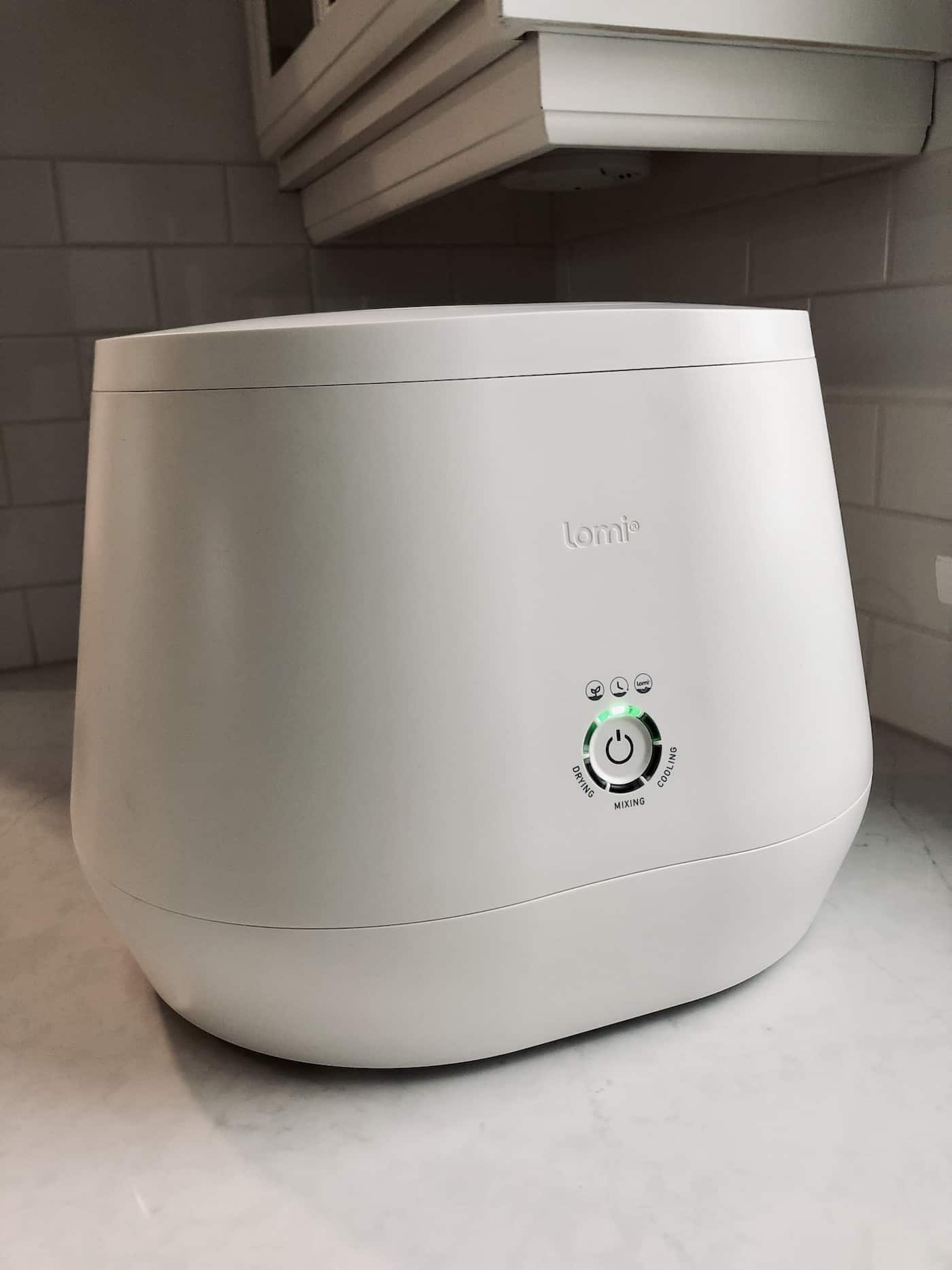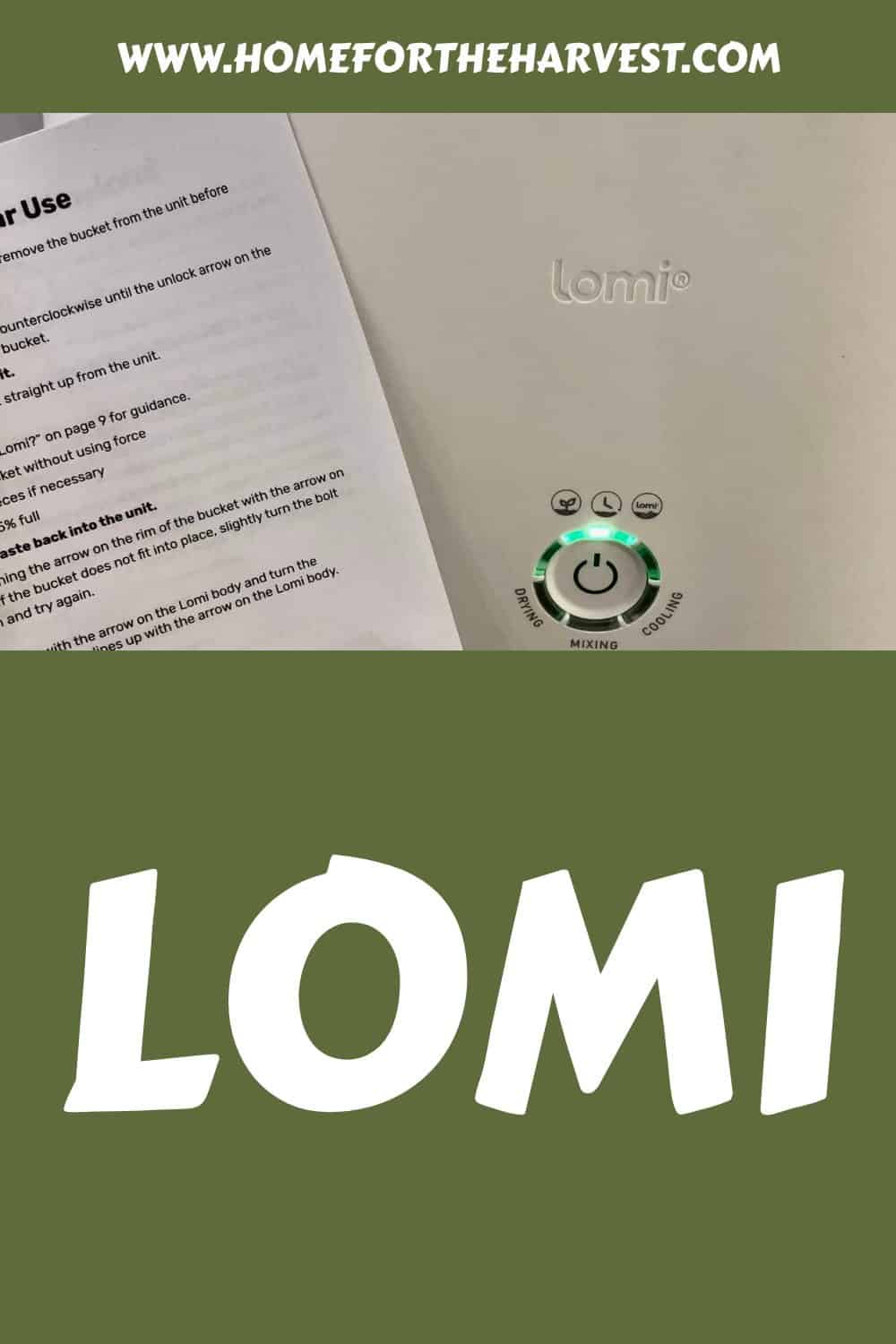Chances are you’ve heard about Lomi, the new electric composting unit for your kitchen food scraps. There’s a lot to like about this indoor composter!
Lomi is an in-home waste reduction machine for decomposing food waste, bioplastics, and trimmings from houseplants. This countertop kitchen appliance has three modes: a quick cycle for breaking down waste, a special cycle for decomposing bioplastics, and a longer cycle for creating nutrient-rich dirt to add straight to your garden.
Let’s look at Lomi more closely, including how to set it up and tips for using a Lomi composter.
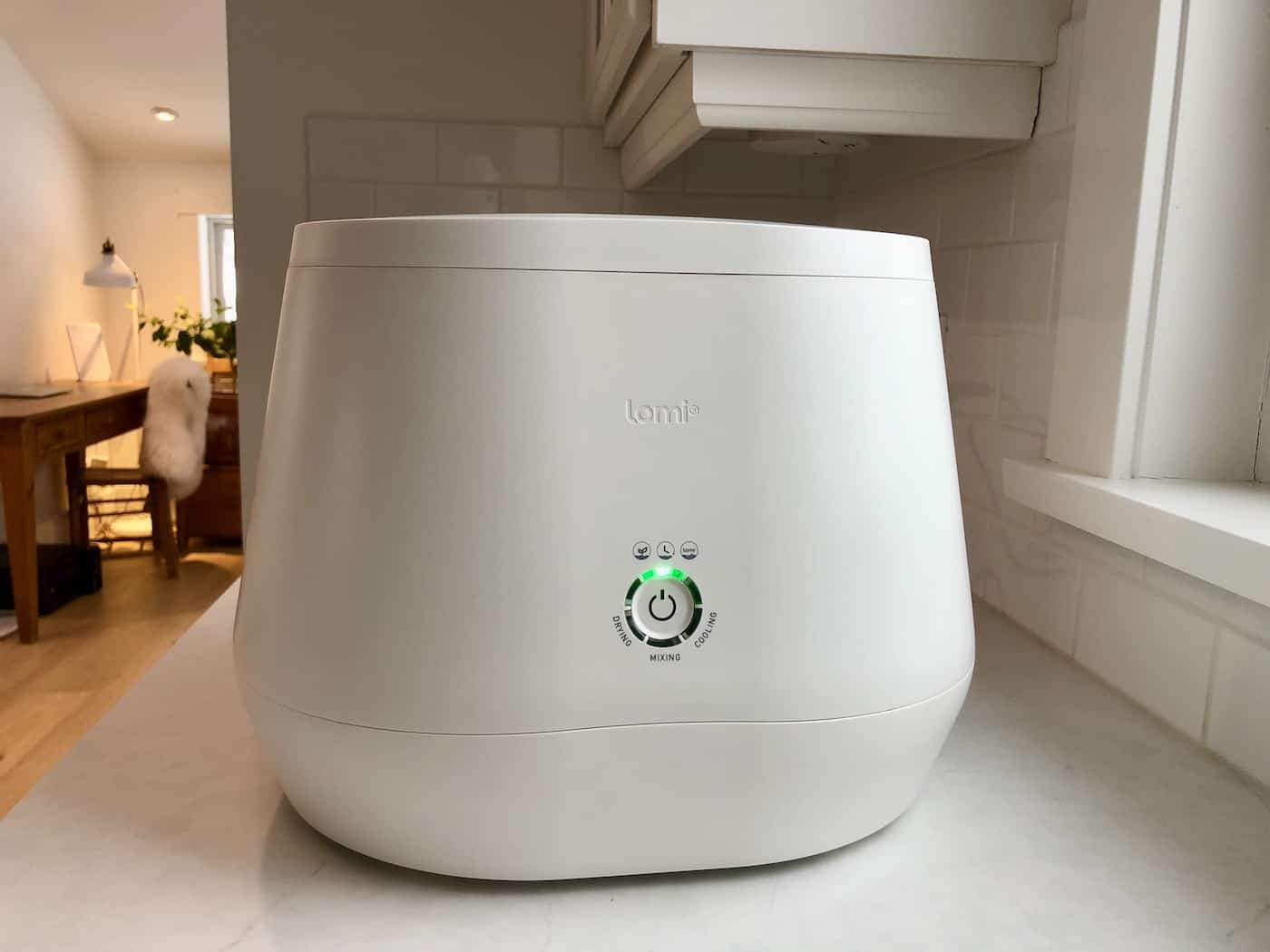
Disclosure: This Lomi unit was gifted to me by Pela, the manufacturer of Lomi.
Lomi: A home composter for kitchen waste
The Lomi Composter is a small-scale electric composting unit that reduces the volume of food scraps, bioplastics, paper products, houseplant trimmings, and even small amounts of yard waste. Lomi machines can be used solely to reduce the overall volume and mess of material going into the garbage can and/or household green bin or they can be used to create a soil-like compost that can be added to potting mix or an outdoor garden.
The Lomi compost process can break down household waste such as vegetable food scraps, meat & fish, leftovers (casseroles, soups), small soft bones (chicken & fish), soiled paper products, compostable bioplastics, coffee grounds, houseplant foliage. There are only a few types of food scraps that can’t be recycled in Lomi (mainly larger hard items like avocado pits and beef bones).
Lomi food waste recyclers contain two carbon filters to reduce the odor of mixed food scraps before and during the electric composting cycle. Lomi converts the mixed household organic waste into an end product that generally has a faint vegetable soup scent.
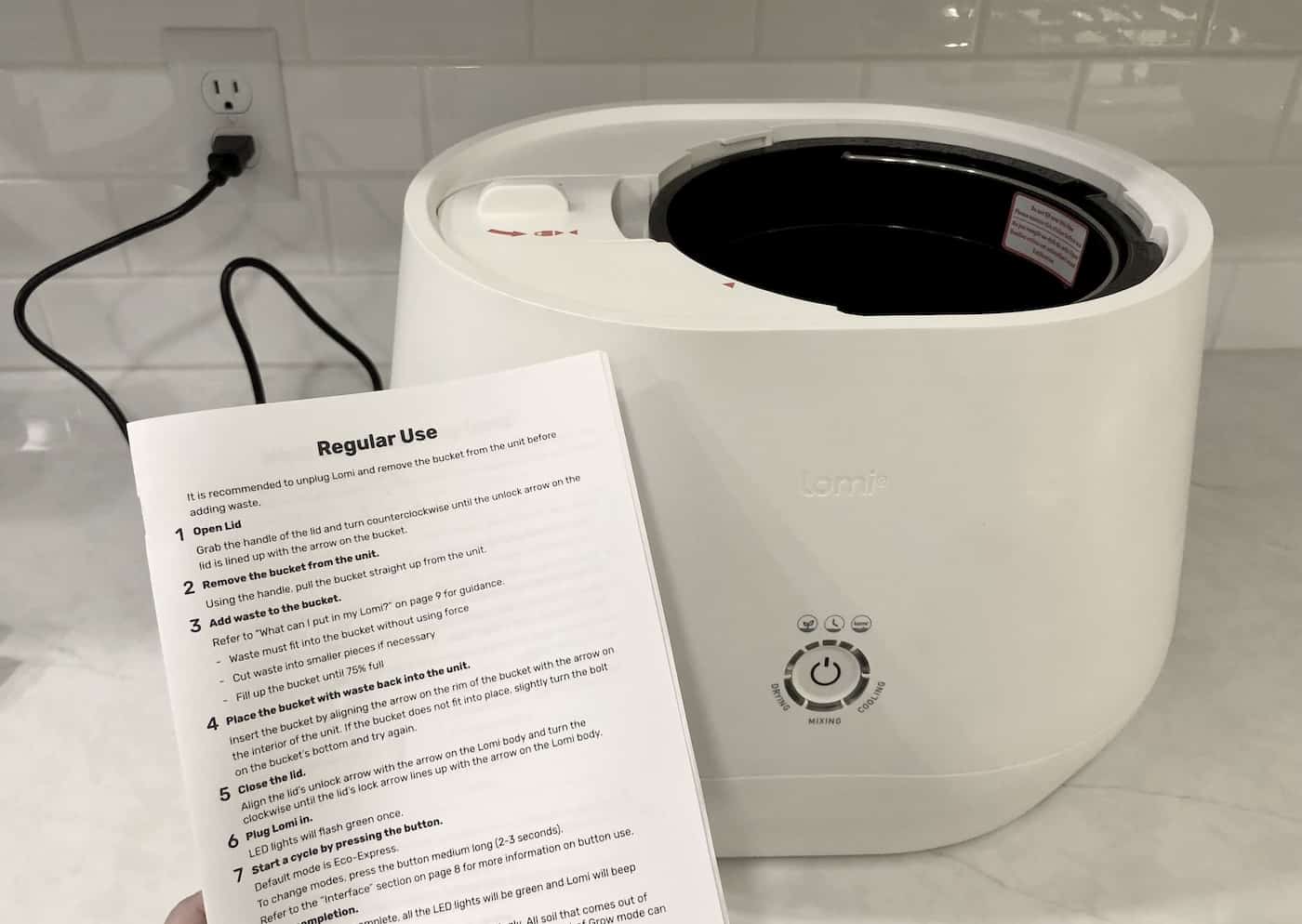
Lomi units: The details
Lomi composting units are made of white plastic outside housing with metal working parts inside the machine. The units take up just over a square foot of space, with a width of about 16″, a depth of 13″, and a height of 12” tall. These units are similar to a home bread maker or air fryer in size. You’ll also need to account for 6″+ of space behind the unit for airflow plus some vertical height above the unit to remove the lid and remove the inner bucket. The assembled Lomi machine weighs about 20 pounds.
The Lomi Composter unit costs $499 USD. A 2-year subscription for air filter charcoal and LomiPods costs $39 every 3 months. You can also find Lomi on Amazon.
Lomi units are recyclable. Lomi is also carbon-neutral and waste-free. The white outer housing is made from recyclable plastic while the inner portions are recyclable metals. While the unit can be recycled at a depot, Lomi can also be returned to the manufacturer as part of the Pela 360 Program.
“Of course, we wanted to make Lomi out of compostable bioplastics but we have to adhere to very strict safety requirements to make sure Lomi is safe for your home! Lomi will also be a part of our Pela 360 Program so instead of going to the landfill, you have the option to send it back to us!”
Pela, Lomi Manufacturer
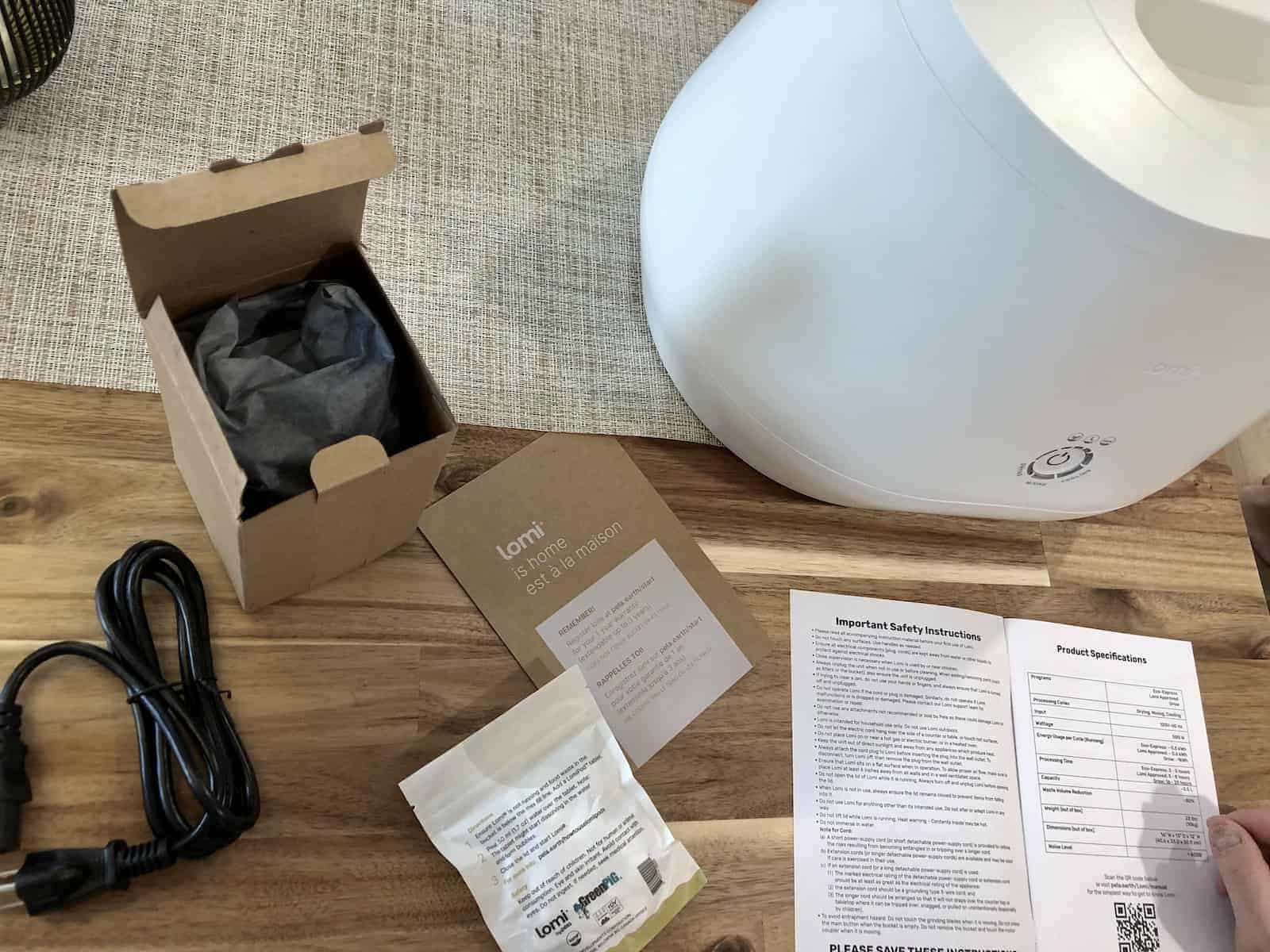
Setting up a Lomi compost machine
Lomi indoor compost machines are quite easy to set up. There are a few initial set-up steps to do before the first cycle, but once it is set up, the machine is low-maintenance day-to-day.
Lomi is almost ready to use straight out of the box. The main setup involves filling the two air filter boxes with charcoal bits and plugging the electrical cord into the unit.
Start by removing all the parts from the box. Place the main unit on a dry, flat, stable surface. Open the back vent of the unit, and remove the rectangular filter. Use the wingnuts to remove the lid of the filter box. Then fill the air filter box with the included charcoal bits.
For the top filter, first, remove the big main lid from the top of the Lomi unit. The cylindrical air filter is off to the side of the main bucket area. Twist the top of the cylindrical filter off and fill the empty tube with more charcoal bits. Replace the filter back into the main unit.
Once both filters are back in place, attach the electrical cord. The Lomi bucket can then be filled with food waste for its first composting cycle.
Here is a detailed guide all about how to set up a Lomi composter.
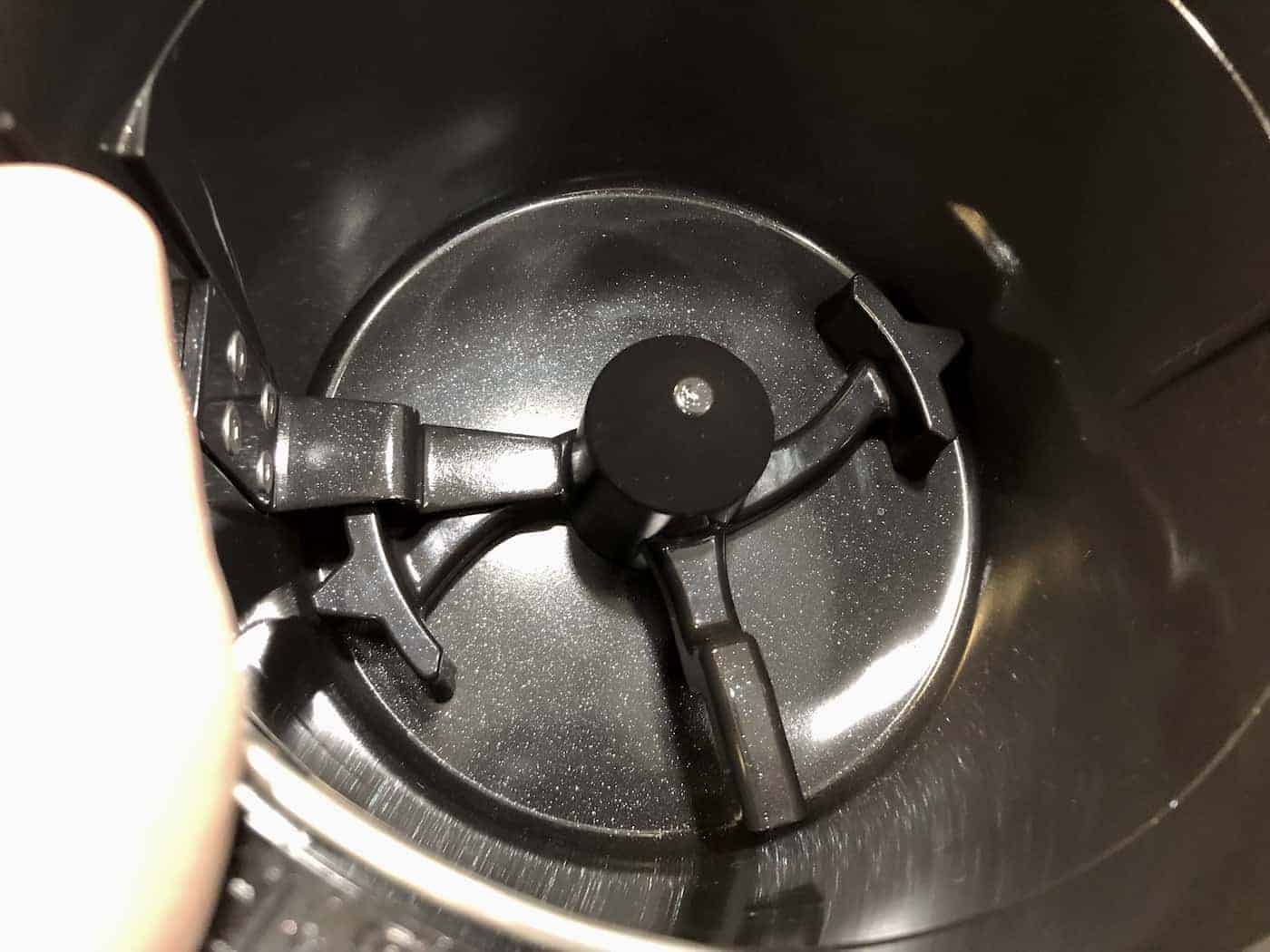
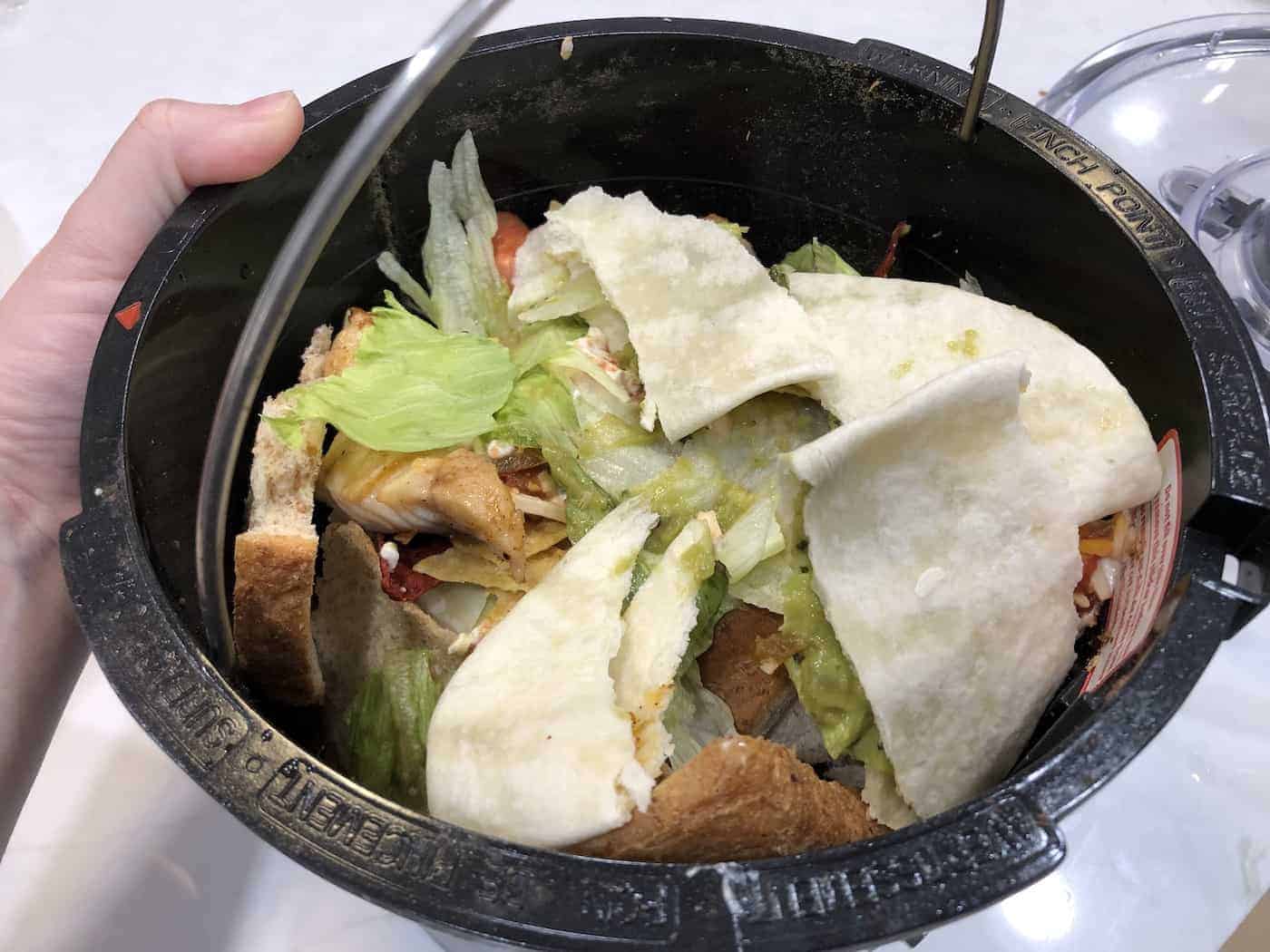
What can go into a Lomi composter?
Lomi composting machines accept most types of food waste with a few exceptions. These digesters also accept certain bioplastics and plant trimmings. Here are some items that can go into Lomi, plus some items that can’t go into Lomi.
Adding a mix of different waste products tends to work better than only one or two types of food scraps. Try to add a varied mixture if possible. The Lomi bucket has a 3L maximum capacity, but should only be filled about ¾ full for best results.
Things to put into a Lomi composter
- Fruit & Vegetable Scraps
- Meat Scraps
- Dairy Products
- Baked Goods, Cereals
- Plate Scrapings
- Leftovers
- Small, Soft Bones (fish, chicken bones from broth)
- Coffee Filters
- Teabags
- Houseplant Foliage
- Flowers
- Small Yard Waste
- Packaging Marked “Compostable” or “Biodegradeable” (on Lomi-Approved mode only)
In addition to the above items, you can also add limited amounts of the following items:
- Soiled Kitchen Paper Products (paper towels, tissues)
- Uncoated Paper Food Packaging (plates, cups, take-out trays)
- Dense Plant Matter, Chopped (coconut shells, corn cobs)
- Liquid Food Waste (soups, smoothies)
Adding too many paper products to Lomi (say, more than 4 napkins) will result in a fluffy, voluminous end product that doesn’t resemble compost. Adding too much dense plant matter can result in visible desiccated food chunks in the end product.
Things not to put into a Lomi composter
- Fruit Pits (avocado, peach, mango)
- Hard or Large Bones (beef, pork, chicken)
- Cooking Oils (vegetable oil, bacon grease)
- Sugary Liquid (juice, soda, alcohol)
- Cardboard
- Bathroom Waste (diapers, wipes, hygiene products)
- Pet Waste
- Petroleum Products (styrofoam, regular plastics, lined packaging)
- Metal
- Glass
Adding cooking oils (or foods that are overly greasy) can lead to a greasy end product with a somewhat-gross consistency (like cookie dough, but without the nice smell). Avoid putting oil or too many greasy foods into the Lomi as it does not break down oils and the oil will therefore remain in the end product.
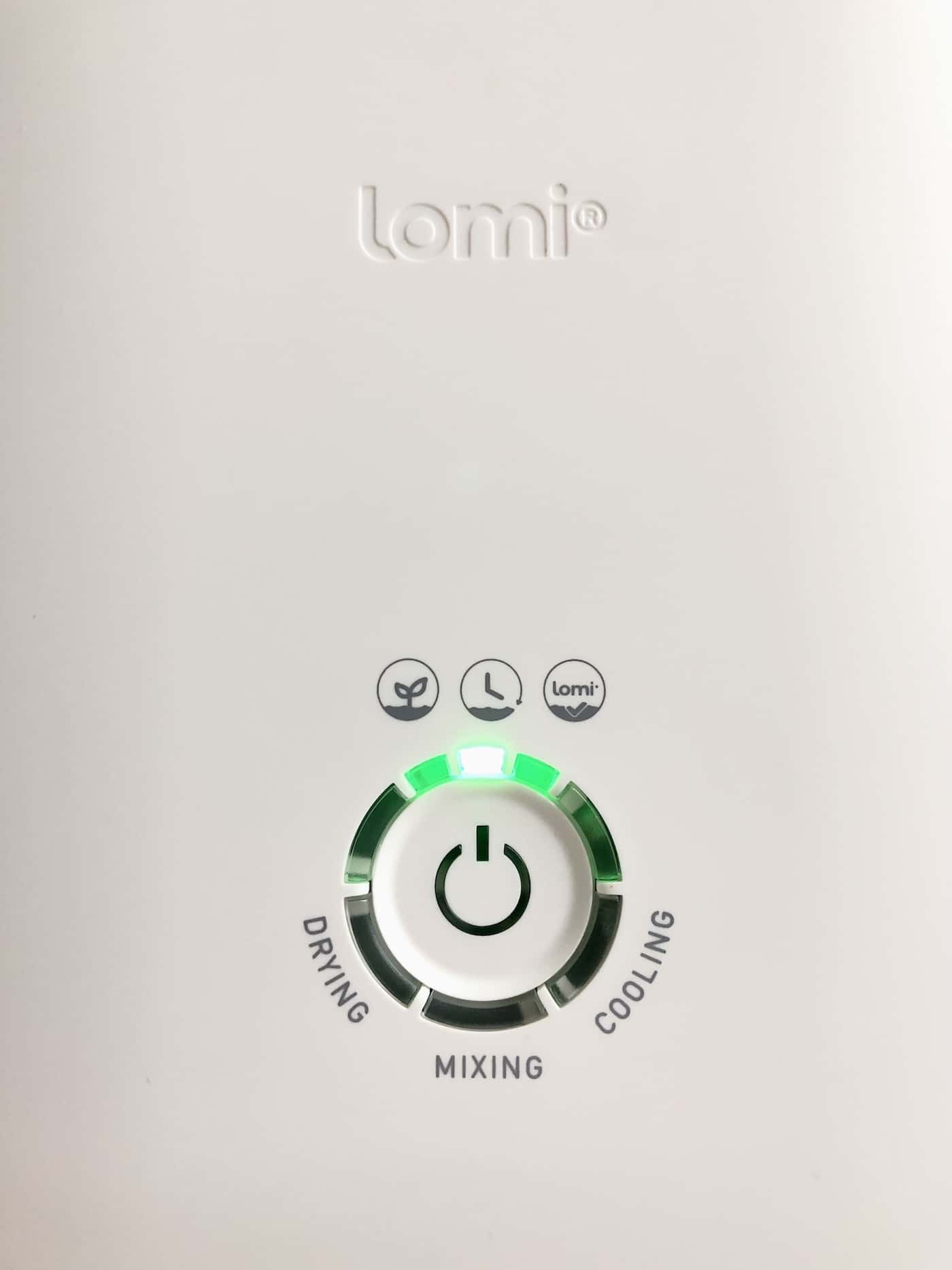
Lomi modes
The Lomi Composter has three modes: Eco-Express Mode, Lomi Approved Mode, and Grow Mode. The Eco-Express mode is perfect for quick waste volume reduction, Lomi Approved Mode is for decomposing bioplastics, and Grow Mode is a longer cycle that produces ready-to-use compost for plants. Here are the details of each of these three modes.
1. Eco-express mode
Eco-Express Mode is a short, intensive cycle that dries and drastically reduces the volume of food waste. This mode takes about 4 hours and produces a substance that looks a bit like dried-out brown grass clippings and smells like vegetable soup.
The end product from Eco-Express Mode is meant to be put in the green food waste bin or into your outdoor home compost. This mode doesn’t produce dirt that can be added directly to the plant potting mix. For that, you’ll want to use the longer Grow Mode (see below).
The main benefit of Eco Mode is that it deals with food waste immediately and turns it into a non-gross substance. There are no slimy messes inside compost bags, no rotting smells in the house, and no half-full bags of food scraps sitting in the freezer to keep them from smelling. Your green bin’s volume is also reduced to about 1/5th of what would be in it without Lomi (plus no flies).
As advertised, Eco-Express Mode does seem to reduce food waste volume by up to 80%. The manufacturer states that Eco-Express Mode uses less than 0.60 kWh of electricity per 4-hour cycle (source: Pela Support). Assuming the October 2021 US Average Price of Electricity (Residential) of 14.11 cents per kWh (source: US EIA), one Eco-Express Mode cycle likely costs about 8 cents to run.
2. Lomi approved mode
Lomi Approved Mode is also known as Bioplastics Mode. This specialty cycle is designed to break down bioplastics like compostable packaging. You can use Lomi Mode to decompose compostable cutlery, compostable coffee cups, compostable take-out containers, or other similar items marked “compostable” or “biodegradable”. Lomi Approved Mode takes 5-8 hours to run one cycle.
The Lomi Approved cycle should not be run with bioplastics alone as the machine depends upon moisture from the breakdown of food waste. Regular household scraps should be mixed in with the bioplastics. The manufacturer recommends tucking the bioplastics around the side of the bucket rather than placing them on top. Lomi Approved mode is the only mode that should be used when any bioplastics are in the bucket.
The end product from Lomi Approved Mode is a dry mixture that is meant to be put into a green bin for disposal. Lomi recommends against putting compost from bioplastic mode into your outdoor compost or using it as dirt for plants.
The main benefit of Lomi Approved Mode is to reduce the volume of bioplastics and packaging so that they are ready to go directly into your green bin rather than sorting them separately and potentially having to take them to a specialty recycling depot to ensure they are properly disposed of in a sustainable manner.
Lomi Approved Mode gives consumers more control over packaging waste by allowing them to break down compostable plastics at home rather than relying on external parties. This mode is designed to use less than 0.75 kWh of electricity. Given an electricity cost of 14.11 cents per kWh, running a cycle of Lomi Approved mode would cost about 11 cents.
3. Grow mode
Grow Mode is the Lomi cycle setting for producing nutrient-rich compost from everyday waste that can be used in potting mix for your houseplants or in an outdoor garden. Grow Mode is the longest mode, taking around 16-20 hours for one cycle to complete.
The end product from Grow Mode is a dry mixture that is somewhat more homogenous than the other shorter modes. The Lomi Compost does resemble the compost that comes out of an outdoor composter, perhaps with a lighter appearance and the odd chunk of recognizable dried food. While it’s not the “black gold” that you get from making outdoor leaf mold, it certainly appears to be a nice organic compost product and likely makes a quality natural soil amendment with ample macronutrients and micronutrients for your plants.
Grow Mode is a great way to recycle indoor food waste and plant trimmings into your own homemade plant food without setting foot outdoors. Grow Mode uses about 1 kWh of electricity per 20-hour cycle. Given an electricity price of 14.11 cents per kWh, a cycle of Grow Mode might cost about 14 cents on your electric utility bill.
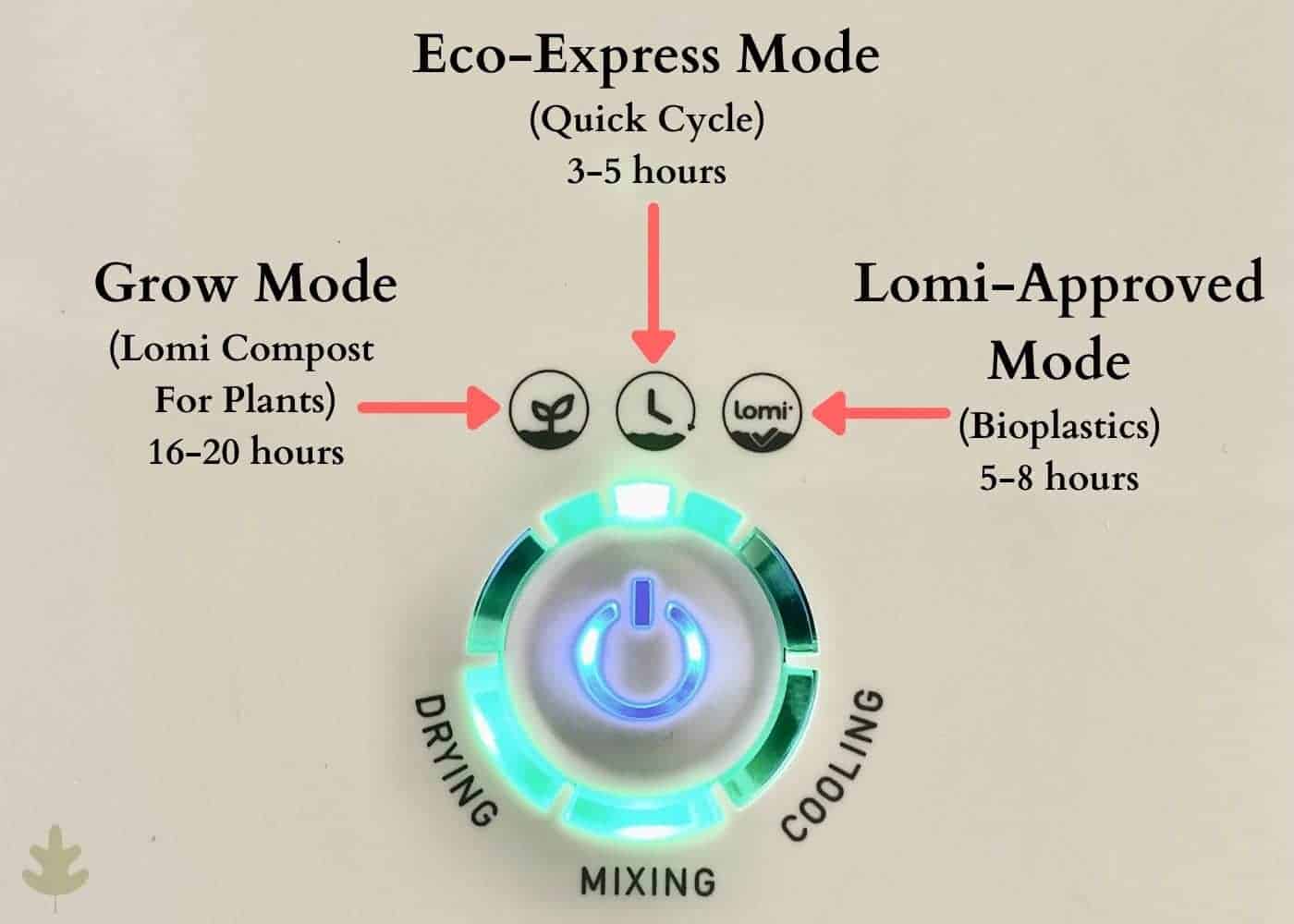
How to start Lomi up on different cycles?
Lomi compost machines have only one button. While this gives them a nice clean appearance, it can take a bit of practice to learn how to start the machine up on the different cycles. In general, a short press (less than 1 second) starts a cycle. A longer press (about 3 seconds) changes the type of cycle between the three mode options. The Lomi unit will beep at the start of the cycle and will beep again when the cycle is complete.
The default mode is Eco-Express Mode. Eco-Express mode is indicated by the clock icon and takes 3-5 hours to complete. The second available mode is Lomi-Approved/Bioplastics Mode. Lomi-Approved mode is indicated by the “lomi”+checkmark icon and takes 5-8 hours. The final available mode is Grow Mode. Grow Mode is indicated by a sprout icon and takes 16-20 hours per cycle.
1. Starting Lomi on Eco-express mode for a quick cycle
Eco-Mode is the first mode (default mode) available when the Lomi button is pressed. This mode has a little clock icon. To use Eco-Express Mode, press the big button once. Press the button firmly but do not hold it for over 1 second. This will start the 3-5 hour Eco-Express Mode cycle.
2. Starting Lomi on Lomi-approved biodegradable plastics mode
Lomi-Approved Mode (for composting biodegradable plastics) is the second mode option available. To switch the mode to Lomi-Approved, the button must be held down for 2-3 seconds. Holding the button down for 2-3 seconds will cause the LED light icon to move to the right, under the “lomi”+checkmark icon. Give the button a quick press to start the cycle on Lomi-Approved Mode.
3. Starting Lomi on grow mode for plant food compost
Grow Mode (to make plant dirt) is the third mode available. This mode has a little sprout icon, which is located to the left of the default express cycle.
To start Lomi on Grow Mode, the mode must be changed from the default Eco-Express to the Lomi-Approved and finally over to Grow Mode. The LED light indicator starts on Eco-Express mode. Press the button for ~3 seconds to move the indicator over to Lomi-Approved mode, and then release the button. Then press the button a second time for ~3 seconds to move the indicator over to Grow Mode and release the button. Finally, give the button one quick press (less than 1 second) to start the Lomi on Grow Mode.
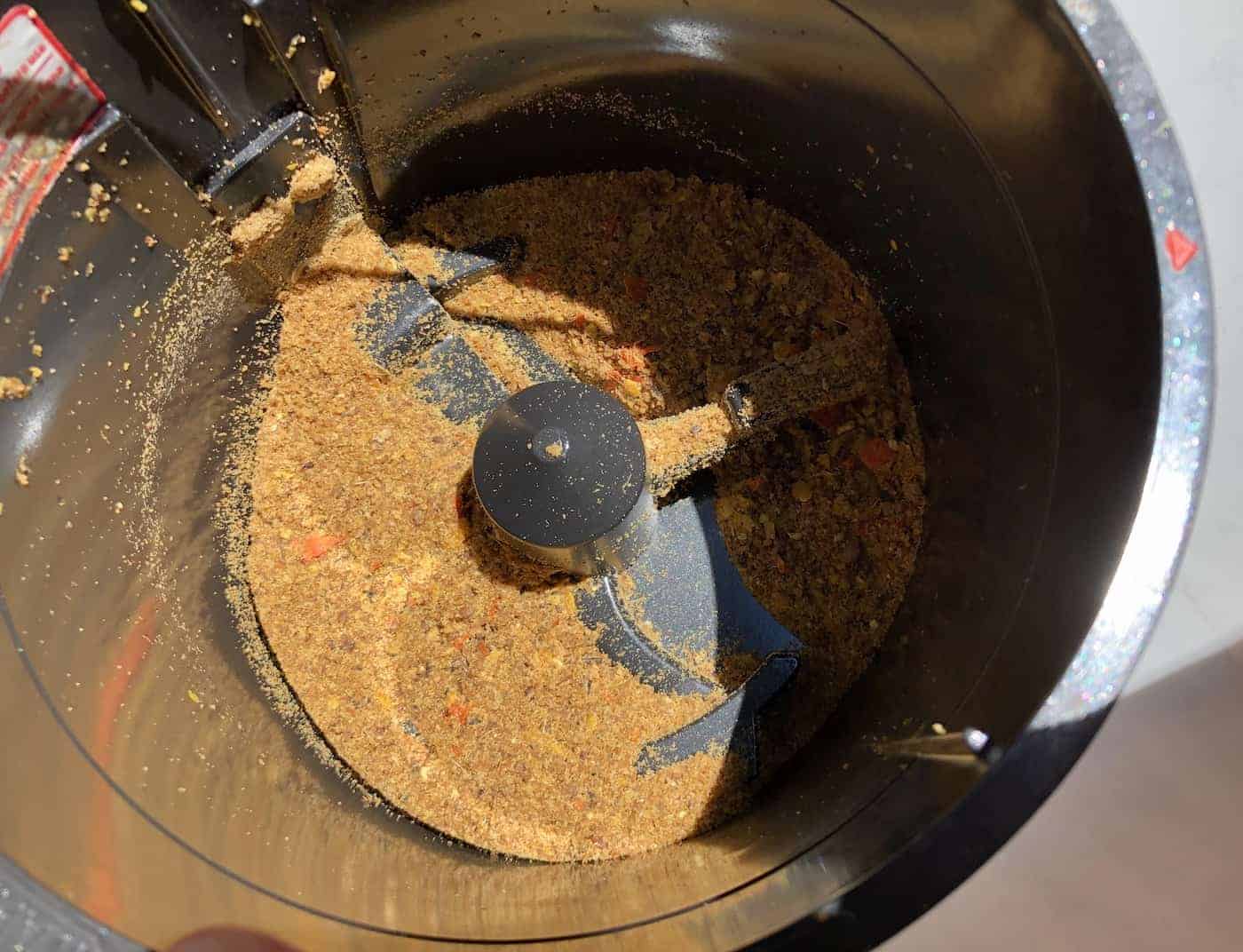
Lomi compost
Lomi Compost is the end product created by the Grow Mode cycle. Lomi Compost, which is also called “Lomi Compost Starter”, is a dry mix of decomposed plant material that is ready to go into the garden.
To use Lomi Compost in your garden or for potting up houseplants, start by mixing up the Lomi Compost with some regular high-quality potting soil. The recommended mixing ratio is 1 part Lomi Compost to 10 parts potting mix.
Once the Lomi Compost is mixed with potting soil, it can be used as topsoil in the garden or used to pot up container plants into new planters.
Read all about Lomi Compost here.
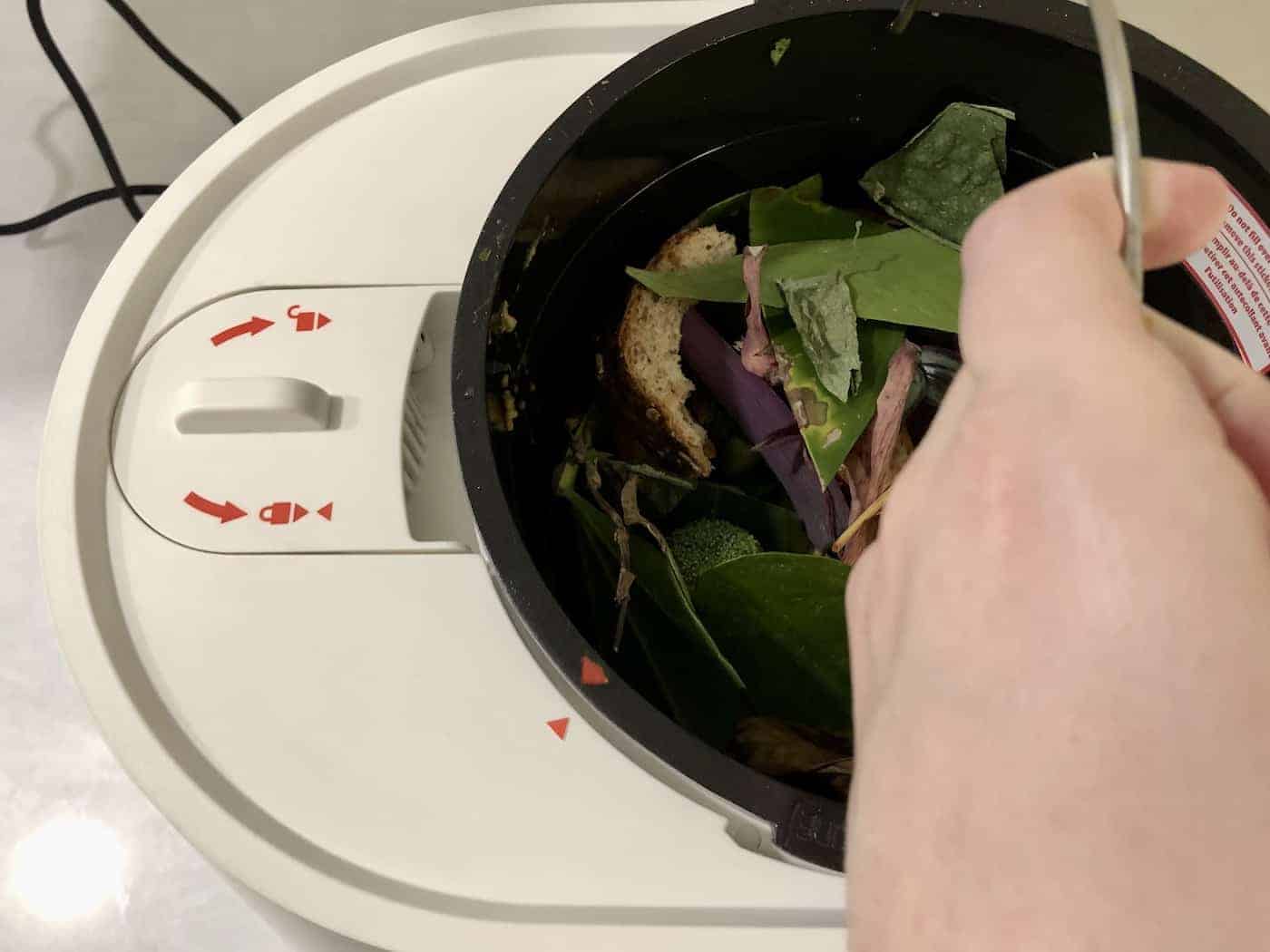
Tips for using Lomi
Here are some quick tips for using a Lomi composter:
- LomiPods are optional during the short Eco-Express Mode, but they are required for both Lomi Approved Mode (bioplastics) and Grow Mode.
- Add a variety of food scraps to each cycle. Try to mix up heavy pieces with lighter pieces in the bucket if possible.
- Don’t let the bucket sit in the machine with food scraps in it for more than a day or two. Run a half-full cycle instead of filling the bucket for a week prior to running the cycle. Alternatively, keep the bucket in the fridge to minimize odors (the Lomi air filters don’t cycle air when the machine is not running).
- Wash the bucket after each cycle. Don’t let waste build up in the bucket. The bucket can be washed by hand or in the dishwasher.
- Replace the filter charcoal every 3-6 months. The used carbon bits can be placed into the green bin, added to outdoor compost, or mixed into potting soil (use 1 part charcoal to 6 parts soil). Filter replacement is also a good time to order more LomiPods.
See my Lomi Review for more tips.
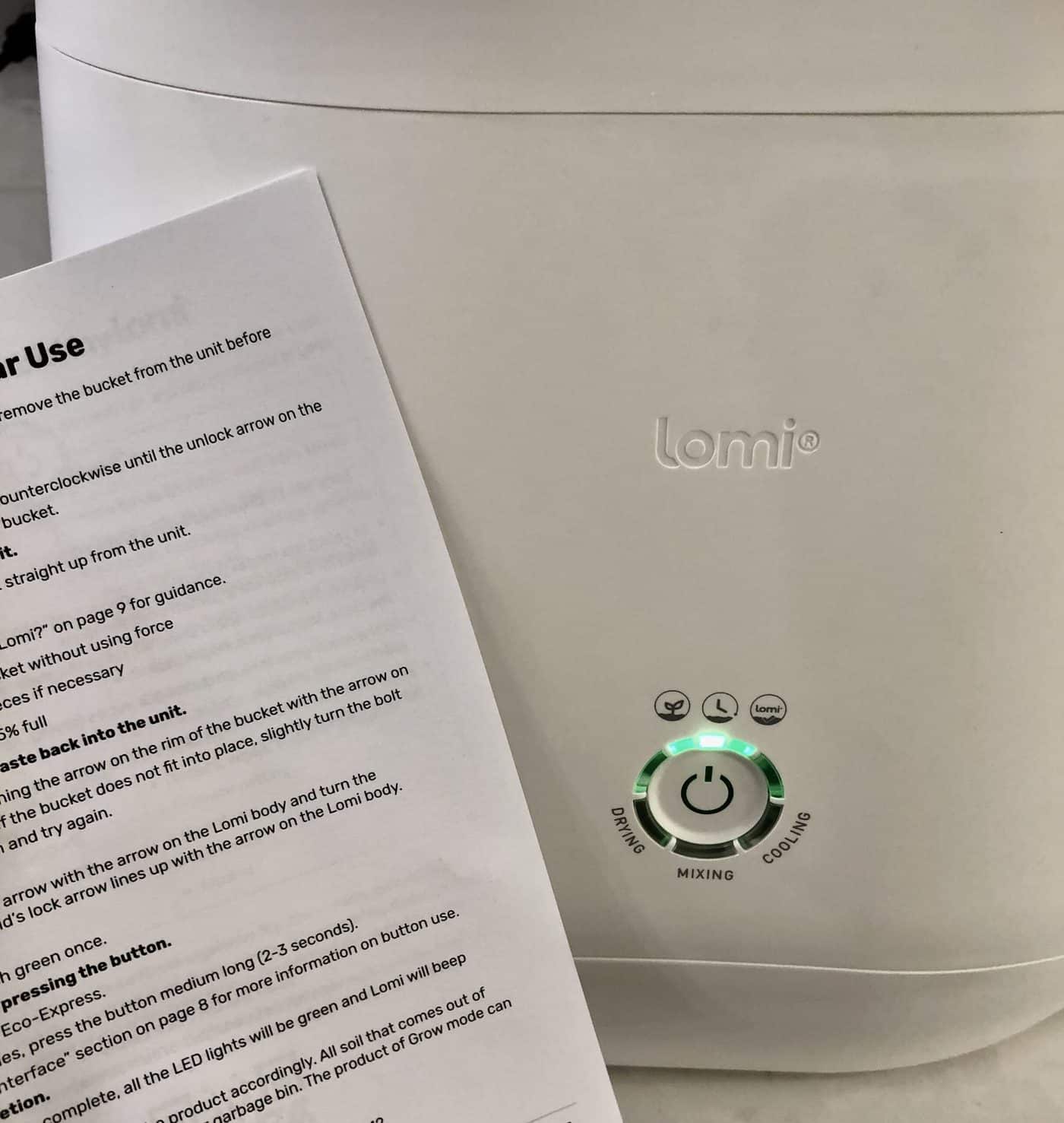
Lomi noise
Lomi compost machines do make a moderate amount of noise during an active cycle. The noise that Lomi makes sounds a bit like a printer (especially if you’ve heard a printer go through a print head cleaning cycle). Occasionally the Lomi machine makes a faint groaning noise during longer cycles. Lomi can also make grinding noises and this may indicate an obstruction (see instructions from Lomi here).
“Lomi makes noise comparable to other small countertop appliances which is less than 60 db. (Don’t worry, that’s a lot less than a blender or food processor!) It’s around the same or less than a coffee maker, modern dishwasher, etc!”
How Loud Is Lomi?, Pela Support
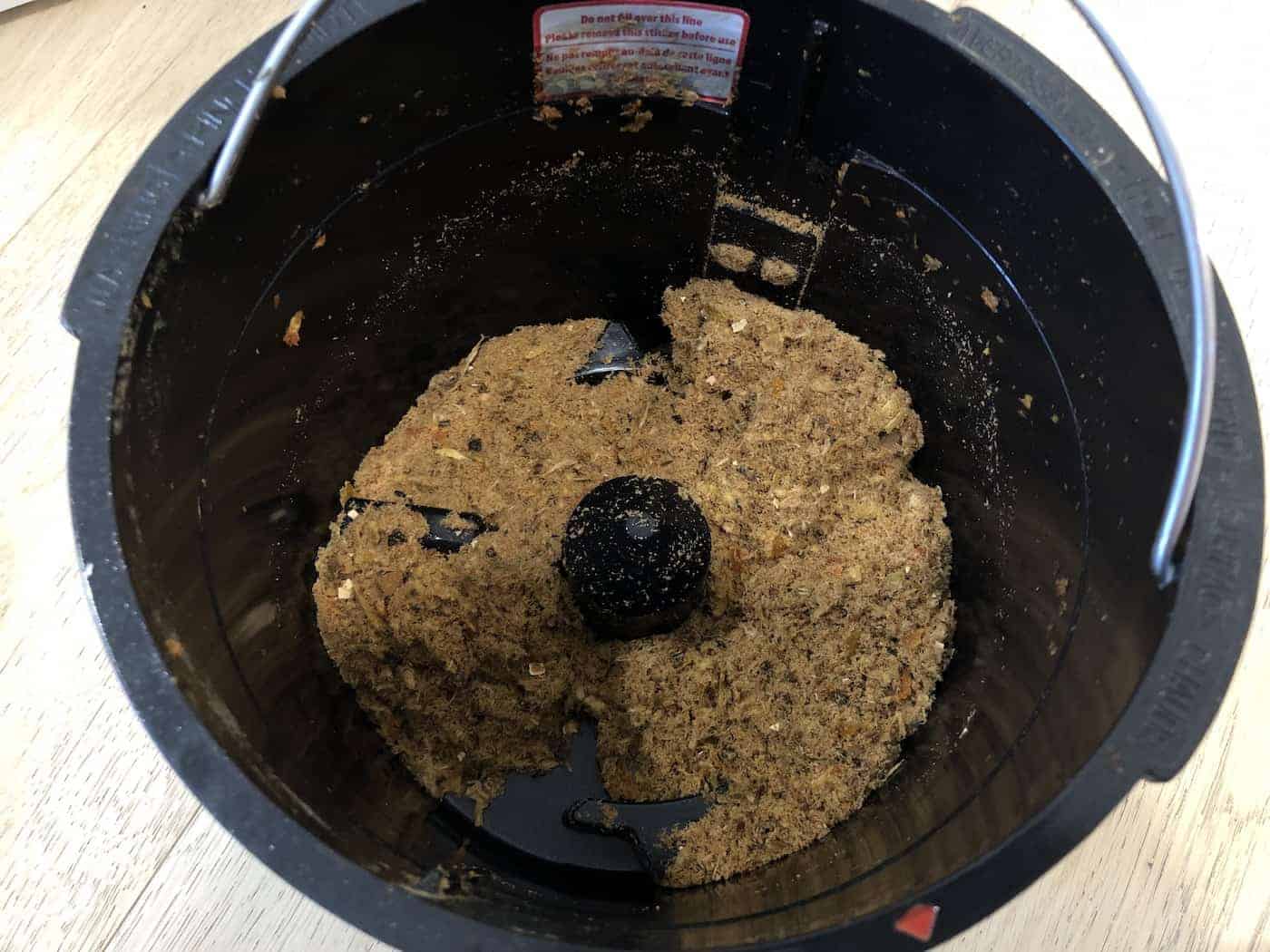
Lomi alternatives
There are a few alternatives to Lomi. Here are some other options to check out in comparison:
Other indoor electric composters
- FoodCycler by Vitamix
- Zera Food Recycler by WLabs
- Electric Tumbler Composter by BeyondGreen
- Small-Scale GG-02 Electric Composting Unit by Oklin
Non-electric indoor composters
- Worm Factory Indoor Composting Bin
- Bokashi Indoor Microbial Composter
High-performance outdoor composters
